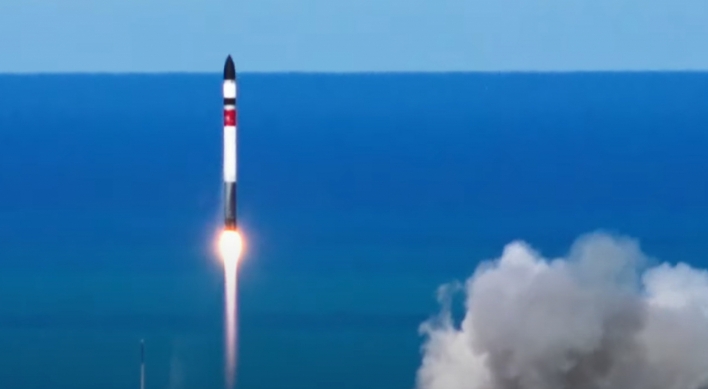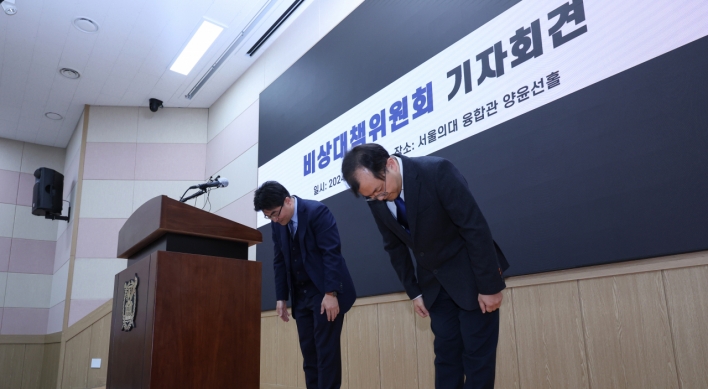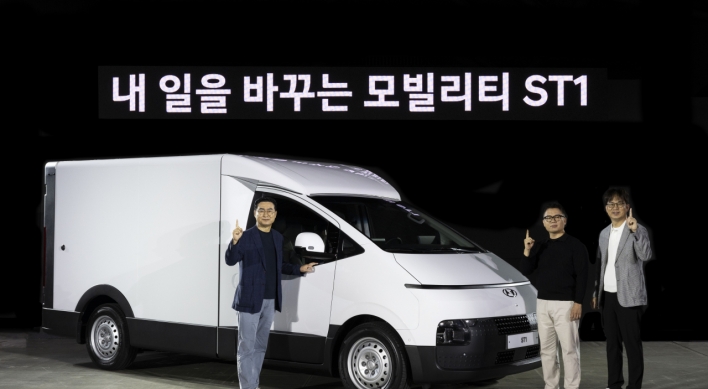[Editorial] No more pie in the sky
Unification prep committee should focus on big picture
By Korea HeraldPublished : Oct. 16, 2014 - 21:58
The second meeting of the presidential committee for unification preparation held Monday saw numerous plans put forward by the 50-member committee.
The plans and reports ranged from a 10-year project to provide water, sewerage and heating for 1 million households at a cost of 9 trillion won; connecting North Korea’s railroads to South Korea’s; establishing a so-called “Northeast Asia Development Bank” to finance infrastructure building in the North, including joint development of natural resources and joint development of a farming complex; a health care program for mothers and infants; the building of a South-North joint DMZ world eco peace park; a world peace conference presided over by Park; as well as drawing up of a statement on unification and a road map for unification.
The meeting, chaired by Park, was initially planned for the end of the year, but was rescheduled, possibly because of the unexpected visit to Incheon earlier this month by the top three North Korean officials with their offer of the second round of high-level talks. Seoul, on Monday, had suggested Oct. 30 for the high-level talks and the Blue House must have had this date on mind when it brought forward the unification preparation committee meeting by two months.
Most of the projects or plans reported on Monday require North Korean participation or permission before they can be implemented. In other words, many of the plans are merely pie in the sky unless inter-Korean relations suddenly improve.
As some pundits have said, most of the plans reported on Monday look beyond the May 2010 sanctions imposed on North Korea in response to North Korea’s torpedoing of a South Korean naval vessel. Indeed, during the inaugural meeting in August, Unification Minister Ryoo Kihl-jae clarified that the committee was not a venue for discussing the May 2010 sanctions.
And that is just as well, as the committee of this size and scope would be better utilized in drawing up a broad vision rather than action plans. Those things are better left to the Unification Ministry, research institutes and other relevant ministries that are already dealing with unification issues.
At Monday’s meeting, Park asked for plans for North Koreans’ welfare, pension and unemployment benefits to be prepared. Whether the current committee should deal with such post-unification plans is questionable. In all likelihood, the committee has a limited lifespan and unification is not imminent. As such, discussions of such post-unification issues by the committee seem inappropriate and premature. Again, specific plans and policies can be assigned to the relevant organizations to develop.
The drafting of a “unification charter” is a mission that seems best suited to the preparatory committee for unification. The committee has been charged with drawing up a draft declaration by the end of the year to be followed by public discussions in the first half of next year.
As noted by Park at the committee’s inaugural meeting, the charter would contain a clear message for South Koreans, North Koreans and the international community. It would outline the reasons and the legal grounds for unification, the principle and process of unification, and the responsibilities of the government, among other matters.
Forming a consensus for unification and drawing a long-term road map for unification are areas where the committee may be most effective. The committee should focus on drawing the big picture, setting aside political considerations. The rest of the work can be done by the already existing organizations.
The plans and reports ranged from a 10-year project to provide water, sewerage and heating for 1 million households at a cost of 9 trillion won; connecting North Korea’s railroads to South Korea’s; establishing a so-called “Northeast Asia Development Bank” to finance infrastructure building in the North, including joint development of natural resources and joint development of a farming complex; a health care program for mothers and infants; the building of a South-North joint DMZ world eco peace park; a world peace conference presided over by Park; as well as drawing up of a statement on unification and a road map for unification.
The meeting, chaired by Park, was initially planned for the end of the year, but was rescheduled, possibly because of the unexpected visit to Incheon earlier this month by the top three North Korean officials with their offer of the second round of high-level talks. Seoul, on Monday, had suggested Oct. 30 for the high-level talks and the Blue House must have had this date on mind when it brought forward the unification preparation committee meeting by two months.
Most of the projects or plans reported on Monday require North Korean participation or permission before they can be implemented. In other words, many of the plans are merely pie in the sky unless inter-Korean relations suddenly improve.
As some pundits have said, most of the plans reported on Monday look beyond the May 2010 sanctions imposed on North Korea in response to North Korea’s torpedoing of a South Korean naval vessel. Indeed, during the inaugural meeting in August, Unification Minister Ryoo Kihl-jae clarified that the committee was not a venue for discussing the May 2010 sanctions.
And that is just as well, as the committee of this size and scope would be better utilized in drawing up a broad vision rather than action plans. Those things are better left to the Unification Ministry, research institutes and other relevant ministries that are already dealing with unification issues.
At Monday’s meeting, Park asked for plans for North Koreans’ welfare, pension and unemployment benefits to be prepared. Whether the current committee should deal with such post-unification plans is questionable. In all likelihood, the committee has a limited lifespan and unification is not imminent. As such, discussions of such post-unification issues by the committee seem inappropriate and premature. Again, specific plans and policies can be assigned to the relevant organizations to develop.
The drafting of a “unification charter” is a mission that seems best suited to the preparatory committee for unification. The committee has been charged with drawing up a draft declaration by the end of the year to be followed by public discussions in the first half of next year.
As noted by Park at the committee’s inaugural meeting, the charter would contain a clear message for South Koreans, North Koreans and the international community. It would outline the reasons and the legal grounds for unification, the principle and process of unification, and the responsibilities of the government, among other matters.
Forming a consensus for unification and drawing a long-term road map for unification are areas where the committee may be most effective. The committee should focus on drawing the big picture, setting aside political considerations. The rest of the work can be done by the already existing organizations.
-
Articles by Korea Herald


![[Exclusive] Korean military set to ban iPhones over 'security' concerns](http://res.heraldm.com/phpwas/restmb_idxmake.php?idx=644&simg=/content/image/2024/04/23/20240423050599_0.jpg&u=20240423183955)
![[AtoZ into Korean mind] Humor in Korea: Navigating the line between what's funny and not](http://res.heraldm.com/phpwas/restmb_idxmake.php?idx=644&simg=/content/image/2024/04/22/20240422050642_0.jpg&u=)

![[Graphic News] 77% of young Koreans still financially dependent](http://res.heraldm.com/phpwas/restmb_idxmake.php?idx=644&simg=/content/image/2024/04/22/20240422050762_0.gif&u=)




![[Pressure points] Leggings in public: Fashion statement or social faux pas?](http://res.heraldm.com/phpwas/restmb_idxmake.php?idx=644&simg=/content/image/2024/04/23/20240423050669_0.jpg&u=)








